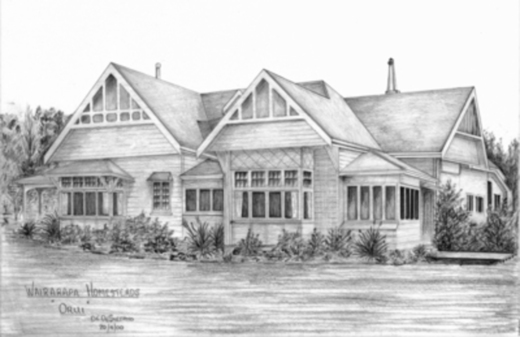Worksop Farm, Charles and Mary Dixon, pioneers
William Mein Smith: Watercolour of Worksop Farm ; Dixon's ; Walter Tiller's grandfather's home, Worksop Road, Masterton, New Zealand. [ca 1863]
Charles Dixon was born in Worksop, England, in 1819 and married Mary Kirton in 1838. They came to New Zealand in 1841 and Charles set up a dairy farm in Karori. Charles was part of the group that set up the Small Farms Association in 1853 whose aim was to provide affordable access to land for the ordinary man.
At that time much of the land in the Wairarapa was tied up in 21 year leases to runholders, who were making it very difficult for anyone else to buy land. Joseph Masters and Henry Jackson, representing the Small Farms Association, met Retimana and his son-in-law Ihaiah Whakamairu at Ngamutawa Pa in March 1853 and as a result the necessary deeds were signed to enable a small farm settlement to go ahead in what is now Masterton. Whakamairu returned to Wellington with Masters to complete the sale.
Charles and Mary Dixon came to Masterton in 1854, possibly as Masterton's first settler, and set up Worksop Farm and an accommodation house which was located between Casel and Kaka Streets. The accommodation house burnt down in the 1880s.
The Small Farms Association had been set up on the premise that common grazing would be available, using the Hundred concept used in English villages, which gave villagers their own smallholding (40 acres) as well as access to a common grazing area. This put Charles Dixon head to head with local runholder W. H. Donald who made it clear he would drive off any of Dixon's cattle that strayed out of the area set aside for town acres.
Dixon Street in Masterton is named in honour of Charles and Mary Dixon.
Henry Bannister writes in 1940:
The little band of pioneers arrived at Worksop Farm, as they called it, on May 21, 1854. After unloading their pack bullocks, of which there were three, and each man had a good swag on his back, there was a good heap on the ground consisting of cross-cut saws, pit saws for cutting timber for the house, axes and wedges, grubbers for cultivating land for wheat, cooking utensils, groceries, clothing and carpenters' tools. While some were unloading the bullocks, another put the billy on and they had their first meal under the spreading branches of a large titoki tree. After finishing their repast they all gathered heaps of bracken fern for bedding, and as it was a fine night and they were all tired, they slept well.Later he writes:
Another old place of interest is the remains of Dixon's Worksop Farm. The old house is there, although a large poplar tree that was blown down by the heavy gale a few years back knocked off one corner. The timbers are mostly sound. One can see the numbers on the bedroom doors, and the boards have Grandfather Jones's saw marks on them. These were the first boards sawn for the Masterton pioneers in 1854.
Charles and Mary Dixon, who owned Worksop Farm.
Sources:
Alexander Turnbull Library
Street Stories: How Masterton's Streets got their names, Gareth Winter, 1998
North of the Waingawa, Ian F. Grant, 1995
Wairarapa Archives
Early History of the Wairarapa, Charles Bannister, 1940
See also:
Last remaining children of Charles Dixon die - 1935

Comments
Post a Comment